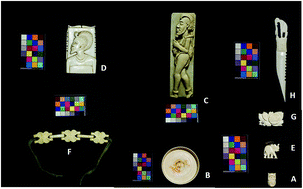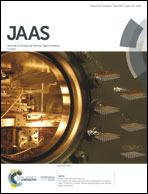Suitability of the Compton-to-Rayleigh ratio in X-ray fluorescence spectroscopy: hydroxyapatite-based materials characterization†
Abstract
In this work, we established a methodology for the analysis and characterization of hydroxyapatite-based materials using X-ray fluorescence. There are several animal hard tissues that can be recognized due to the relative amounts of hydroxyapatite (HAp) and collagen, using vibrational spectroscopy. The same principle can be applied to dental tissues to distinguish between enamel, dentine and root. Using X-ray fluorescence spectra, only the inorganic part can be identified and, sometimes, due to elevated P detection limits, mainly Ca can be detected. Therefore, we have established a methodology for hydroxyapatite recognition using reference samples, in order to obtain a calibration curve of the ratio of the Compton to Rayleigh scattering of the characteristic Kα line of the anode material as a function of the average atomic number of the sample. The reference samples consisted of different proportions of HAp [Ca10(PO4)6(OH)2] and boric acid [H3BO3] reference materials in order to obtain an average Z range of 7 to 14. This calibration curve was developed for a portable X-ray fluorescence setup with triaxial geometry and applied to: ivory jewelry and decorative objects from different origins, with the purpose of establishing differentiation markers, and human teeth before and after erosion processes for demineralization assessment.



 Please wait while we load your content...
Please wait while we load your content...